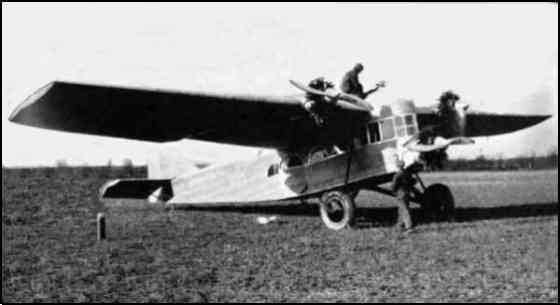

|
| From Maurice Holland's Architects of Aviation, 1951 |
|
The Ford Trimotor was based on the general layout of the highly successful Fokker F.VII/3m (q.v.) three-engined high-wing monoplane, except that the Ford was all-metal --- even to its corrugated metal skinning which earned it the nickname "Tin Goose". It was a flexible design which could be fitted with a variety of power plants in the 300/400-hp power bracket. Many were built and used in different parts of the world, particularly in the less-developed areas, for which the Ford was ideal. With the depression in the early thirties, however, the Ford Company ceased to make aircraft. It was originally designed by William B. Stout, who, in 1966, reintroduced the type for production as the Bushmaster 2000, having modernized the design to meet modern-day requirements in terms of safety, comfort and operational facilities as a simple and cheap transport aircraft for use from small grass fields .CENTER>From THE LORE OF FLIGHT, CRESCENT BOOKS, New York |

|
| The picture is from the collection of George Hicks, |
|
Wright Aeronautical had begun the developement of a radial air-cooled engine which, in my opinion, was the first aviation power plant to fit the job. The original engine was the J4 of 200 horsepower. Its push rods and rocker arms were outside in the air. The engine was crude, but it ran, and weighed half what the Liberty did, with much better economy of both oil and gas. One of these engines was not sufficient to fly our airplane; two of them would give us the same horsepower as the Liberty. However, there was room for a third on the nose of the plane. As an extra safety factor, we made the plane a "trimotor." If one of the three engines should stop, there would still remain enough power to make the next field safely. We revised our Liberty-engine plane by widening the wing ten feet in the center section, rounding off the fuselage up front, and putting one engine in front and a side engine in the leading edge of the wing. The original Ford trimotor was not as it was finally produced. At first, the passengers, seated lower than the wing, could look out in all directions, and even see the rocker arms of the engine working out in front. The pilot sat in a cockpit of his own up above the pasxsengers, with his head sticking out the leading edge of the wing. "Shorty" Schroeder, our test pilot, insisted, as did all other pilots, that he must have his cheek out to feel the air in order to make a correct turn. The plane had a rather remarkable performance for that day and was completely controllable. Autographed: To Walter Lees, whose skill and quick thinking saved the day --- and him too., Sincerely, Bill Stout, Nov. 1952 

|